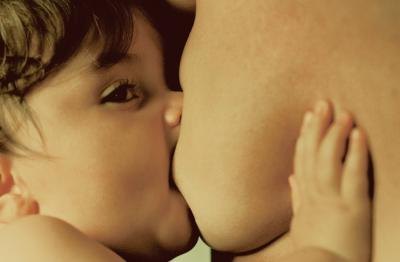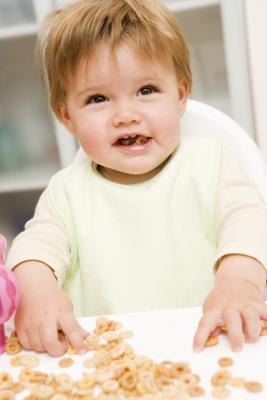Breastfeeding should not be painful, regardless of what you have been told. Breast and nipple soreness when breastfeeding is a sign that something is wrong and such symptoms should never be ignored. Soreness is common during the newborn period, but should never be severe enough to interfere with nursing. Dealing with breast and nipple soreness during breastfeeding is essential, as the longer you wait to begin treatment, the worse the symptoms will become.
Instructions
1 Evaluate and improve your positioning. Poor positioning is the most common cause of breast and nipple soreness when breastfeeding and accounts for approximately 90 percent of early nursing problems. To improve your positioning, you must find a spot where you are able to sit comfortably upright, with your feet squarely and firmly on the floor. Hold your baby so that his stomach rests against yours, but be careful no to extend your baby's head too far. Pillows can assist in elevating your baby to the level of your breast.
2 Make certain that your baby is latched on correctly. Bring your baby to your nipple, encourage her to open her mouth widely and allow your baby to bring your entire nipple and areola into her mouth. If you experience pain or soreness, it is a sign that your baby is not latched on properly. Continuing to allow your baby to suck when not latched on properly can result in prolonged pain and tenderness.
3 Examine your nipples for signs of thrush. Symptoms of thrush include itching, soreness and redness. Thrush is a type of yeast infection, and chances are good that your baby will have thrush if you do. Consult your doctor immediately if you believe thrush may be the cause of your breast and nipple soreness when breastfeeding. Both you and your baby will need to be treated. You can reduce the risk of thrush by washing your nipples with clean, clear water after each nursing and by changing your nursing pads frequently.
4 Determine whether you have inverted nipples. Inverted nipples can prevent your baby from properly latching on because they make it difficult for your baby to pull your areola back into his or her mouth. Inverted nipples can be minor or severe and are caused by adhesions that pull the skin of the areola back into the breast. To determine whether your breast and nipple soreness when breastfeeding is caused by inverted nipples, place your forefinger and thumb behind your areola and press them together. If your nipple dents or bends, your nipples are likely inverted. Having inverted nipples does not mean you cannot breastfeed. Using a breast pump or wearing breast shells can increase your chances of breastfeeding successfully.
5 Avoid using strong, scented soaps and creams on your nipples during breastfeeding, as some of these items can cause dermatitis in sensitive mothers. If your breast and nipple soreness when breastfeeding is related to itchy, cracked, or red nipples, you might be allergic to your current soap or laundry detergent. Try using sterile nursing pads and wash your nipples only with clean, clear water.
6 Change your breast pump. A poorly designed breast pump can cause pain, inflammation and cracked nipples. If you experience discomfort when using your breast pump, try turning down the suction or purchase another brand. Using a breast pump should never cause pain.
7 Take painkillers during the healing process. Acetaminophen is safe for both mother and baby during breastfeeding and the relief it brings can allow you to continue nursing while your breast and nipple soreness is healing. Take the lowest possible dose every 4 to 6 hours, as needed, for no more than a few days.
8 Expose your nipples to air to aid the healing process and prevent many causes of breast and nipple soreness when breastfeeding. Change your nursing pads every couple of hours and spend as much time as you can without a bra or shirt on. Place a towel on your lap while sitting to catch any leaking breast milk. Breast shells are also useful at keeping the nipples dry, and can help protect your healing breasts from bumps.
9 Use a cream designed for breastfeeding. Lanolin, chamomile, and vitamins E, A, and D, can bring soothing relief to sore breasts and nipples. Before using any cream on your sensitive nipples, be certain to perform an allergy test by using the product on the inside of your wrist. Use only those creams that are safe for use during breastfeeding and check the label to determine if you must wash your nipples before nursing.
10 See your doctor urgently if you suspect that your breast and nipple soreness when breastfeeding may be caused by a serious condition, such as mastitis or another bacterial infection. Mastitis can cause considerable pain, fever, chills and an area of hardness and redness in the breast.




















